Many teachers walk into the classroom every morning without considering where students sit. But poor classroom seating arrangements can quietly sabotage even the best lesson plans—causing distractions, disengagement, and uneven participation.
If the wrong students sit together, discussions derail. If some can’t see the board clearly, learning suffers. The whole class feels off-balance if your layout doesn’t support how you teach. When classrooms are small or the students are especially chatty, the problem only grows. You may find yourself spending more time managing behavior than teaching.
The right classroom seating arrangement isn’t just about where students sit—it’s a tool for focus, equity, and collaboration. This guide explores the most effective seating strategies for every classroom size, student type, and teaching goal. You’ll learn to design flexible, practical layouts that improve learning and classroom management.
Introduction
Understanding how classroom seating arrangements affect learning is the first step toward creating an adequate learning space. Before exploring which layouts work best, it’s essential to clarify their classroom seating arrangements and why they play a critical role in today’s classrooms. The following sections will break down the basic definition and explain the growing importance of seating in modern teaching.
What Is a Classroom Seating Arrangement?
A classroom seating arrangement is how desks, chairs, or tables are positioned in a learning space. It includes the layout of student seats, their proximity to the teacher, and how students are grouped or spaced apart. This setup can be simple—like rows facing a whiteboard—or more complex, such as flexible zones with standing desks, floor seating, or collaborative tables.
A well-planned seating arrangement in the classroom isn’t just about where students sit. It’s a tool that supports how the class functions, how the teacher teaches, and how students connect with the material and each other. Whether you use a seating chart, rotate seats weekly, or allow flexible seating, your layout sends a message about how learning happens in your classroom.
The Significance of Seating in Modern Classrooms
In modern education, seating is no longer a static choice. It’s a strategic part of classroom design. How we place students affects more than their comfort—it influences attention, group dynamics, behavior, and academic results.
For example, arranging desks in clusters encourages collaboration. Using a U-shaped layout can improve class discussions. Placing students who need more focus closer to the teacher often reduces distractions. On the other hand, poor seating layouts can lead to disengagement, side conversations, and a lack of inclusion for students with special needs.
As classrooms evolve—embracing digital learning, project-based instruction, and diverse student needs—seating must adapt too. Teachers are no longer just assigning seats. They’re building environments where all learners can participate, focus, and thrive.
In short, the importance of classroom seating arrangements has never been greater. When done right, seating supports both classroom management and meaningful learning.

Why Classroom Seating Arrangements Matter
Before choosing the correct layout, it’s essential to understand why classroom seating arrangements matter. How and where students sit doesn’t just affect classroom appearance—it powerfully influences behavior, focus, learning, and social dynamics.
Impact on Student Engagement and Motivation
Students are more likely to engage when they feel part of the classroom community, and seating plays a quiet but central role.
Learners tend to participate more when they have clear sightlines to the teacher, enough personal space, and proximity to their peers. They ask more questions, join discussions, and stay focused longer. A student tucked away in the back corner of the classroom or stuck between distracting peers may withdraw, even if the lesson is interesting.
But it’s not just about physical placement. Classroom seating arrangements also influence a student’s sense of inclusion. Being near peers with similar energy or academic pace helps students stay confident. Sitting too far from the action can make them feel invisible.
- Clarity – Clear lines of sight to the board and teacher.
- Comfort – A desk that fits, personal space respected.
- Connection – Positioned near peers, they can learn, not just talk with.
- Balance – Not always front or back; rotation allows everyone to refocus.
Even in early grades, simple changes like shifting from rows to semicircles can lead to visible differences in motivation. It’s not about fancy furniture—it’s about thoughtful placement.
Influence on Classroom Management and Discipline
A calm, focused classroom starts with innovative structure—and seating is structure.
Teachers often spend a significant part of the day managing off-task behavior: whispering, side chatter, fidgeting. Much of this isn’t just about the student—it’s about the seat. Some students feed off peer energy. Others shut down if surrounded by too much noise or movement.
Seating can prevent problems before they start:
- Talkative students placed near quiet ones often adjust their energy.
- Separating students prone to conflict can reduce teacher interventions.
- Creating a physical path between groups helps the teacher move, observe, and redirect silently.
A good classroom seating arrangement allows for:
- Smooth transitions between activities
- Clear lines of supervision
- Grouping students without isolating anyone
- Flexibility when behavior patterns shift mid-year
Instead of constantly reacting to behavior, the teacher can create a space that naturally supports better choices. Sometimes, moving a desk does more than a verbal warning.
Role in Collaborative or Individual Learning Goals
Not every lesson requires the same mindset. Some call for silent focus, while others rely on exchange and teamwork. Your seating arrangement either supports that purpose or works against it.
Students arranged in groups of four or five can easily share resources and ideas. Cluster seating like this is ideal for projects, brainstorming, and lab work. However, that layout distracts a reading assessment or test situation.
Matching the layout to the learning goal is more important than choosing “the best” layout.
Think of it like this:
- Individual work → Spaced rows, minimal visual distraction
- Discussion-based learning → Circles or U-shapes
- Project-based learning → Pods or flexible clusters
- Movement-based lessons → Open space, easy-to-shift desks
And for mixed lessons? Many teachers now use zones—rows up front for instruction, clusters on the side for activities, and floor seating in the back for reading.
The right classroom seating arrangement reflects what you want students to do. If aligned with the task, management becomes easier, and outcomes improve.
Different Types of Classroom Seating Arrangements
Not every classroom looks the same—and neither should the way we arrange the seats. Different layouts support different goals, student behaviors, and classroom sizes. Below are some of the most widely used and adequate classroom seating arrangements, their strengths and when they work best.
Traditional Row Seating in the Classroom
The traditional classroom seating arrangement places desks in straight, forward-facing rows. This format has been a cornerstone in education for decades and is still common in high school classroom seating arrangements and lecture-based environments. It maximizes space efficiency and gives every student a clear view of the teacher, board, or screen.
- Ideal for classroom management, as all students face the same direction
- Works well for testing environments and independent work
- Minimizes distractions for focused, teacher-led instruction
- Easy to arrange and maintain
Limitations:
While rows are efficient, they often limit peer-to-peer interaction. This setup is less effective for collaborative projects or group seating arrangements in classroom activities. In large classes—such as classroom seating arrangements for 40 students—rows may create a physical and emotional gap between the teacher and students at the back.
Traditional classroom seating arrangements remain a proven, practical choice for educators prioritizing order, visibility, and structure.
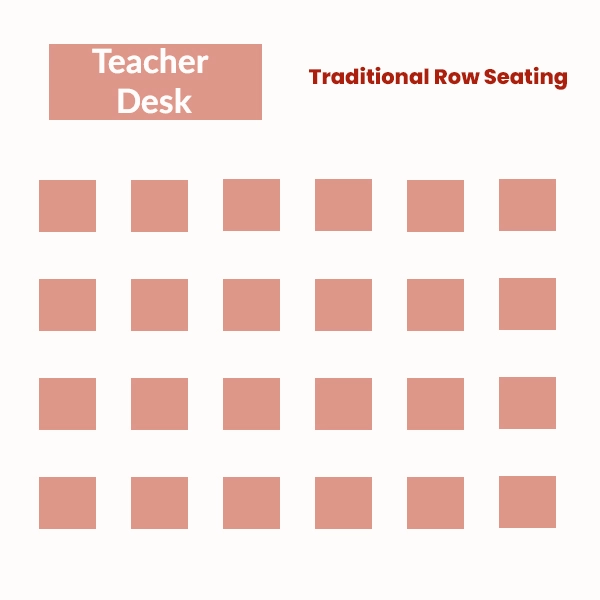
U-Shaped / Horseshoe Seating Arrangement in the Classroom
The U-shaped seating arrangement lines desks along three sides of the classroom with an open center. It’s widely regarded as one of the most effective classroom seating arrangements for fostering interaction while keeping a teacher-centered approach.
- Promotes eye contact between all participants
- Supports discussions, debates, and collaborative learning
- Facilitates movement for the teacher to engage with students directly
- Highly effective for classroom seating arrangements for 20–30 students
Limitations:
In small classrooms, the open center can reduce seating capacity. For classroom seating arrangements for 30 students or more, arms of the “U” may be extended, but this can affect communication across the room.
Versatile and adaptable, this design works well in elementary classrooms, adult training, and presentation-heavy lessons.
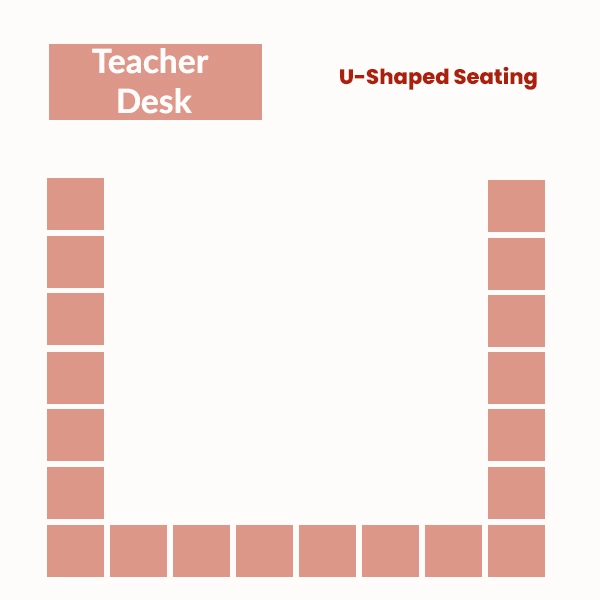
U-Shaped Seating Arrangement for Large Classrooms
The U-shaped seating arrangement for large classrooms adapts the classic U-shape to fit spaces with 30–40 students or more. Desks or tables form three long sides, sometimes with extended “arms” to accommodate additional seating. This format works best in lecture halls, training rooms, or classroom seating arrangements for 40 students where visibility and interaction matter.
- Maintains a clear focal point on the teacher or presenter
- Allows a large group to participate in discussions without losing sightlines
- Works well for presentation-focused lessons and classroom management
- Suitable for integrating technology like projectors and interactive boards
Limitations:
When scaled up, the U-shape can create communication gaps between students at opposite ends. Teachers may need to move frequently to maintain engagement across the room. In narrow classrooms, the extended arms may also reduce walking space.
This seating arrangement is a strong choice for educators who want to balance large group instruction with opportunities for dialogue, making it one of the best classroom seating arrangements for big classes.
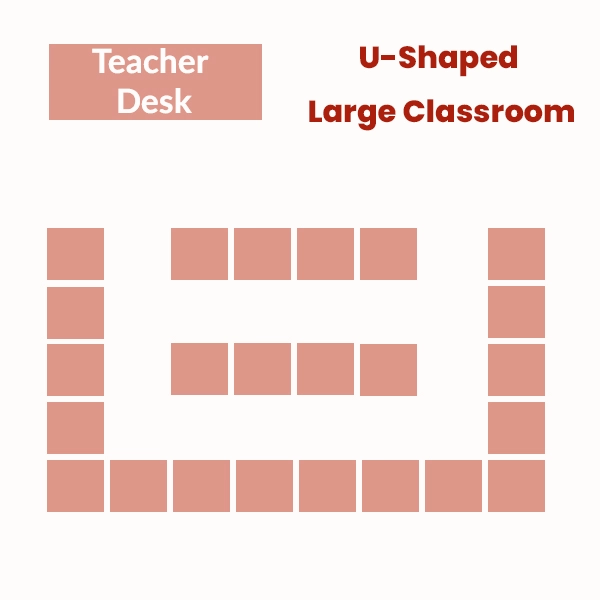
Group Pods / Cluster Seating Arrangement
The group pods or cluster seating arrangement in a classroom places 4–6 desks together, forming small learning islands. This style is typical in elementary classroom seating arrangements and classes that rely heavily on group work. Students face each other, making sharing materials, discussing ideas, and working on joint tasks easier.
- Encourages teamwork and peer-to-peer learning
- Supports collaborative projects and problem-solving activities
- Makes it easier for teachers to assign differentiated tasks to each group
- Can be rearranged quickly for different activities
Limitations:
Group seating can increase off-task chatting, especially in talkative classrooms. It also reduces direct visibility to the teacher in large spaces, affecting focus during lectures.
This seating arrangement is one of the best for elementary classrooms and creative learning environments where collaboration is a priority.
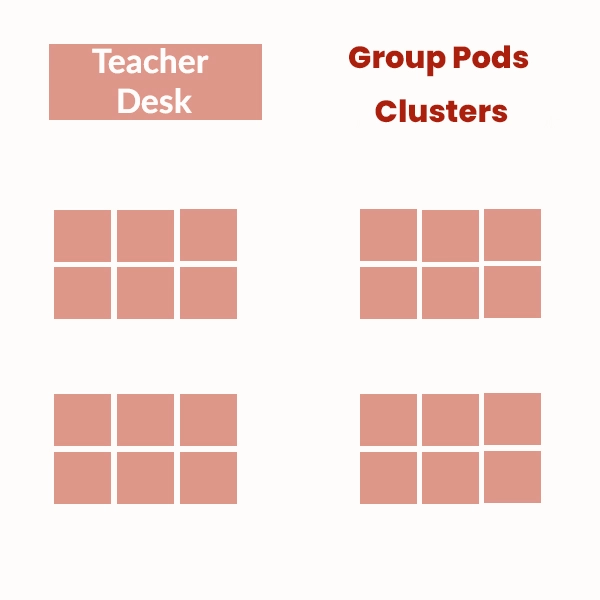
Circle Seating Arrangement in the Classroom
In the circle seating arrangement classroom, chairs or desks are placed in a complete circle with no “front” of the room. This style is ideal for discussion-based learning, culturally responsive classrooms, and activities where every student’s voice is valued.
- Puts all students at the same visual level, reducing hierarchy
- Strengthens listening skills and respectful dialogue
- Works well for classroom seating arrangements for small classrooms and reading groups
- Encourages full participation since everyone is visible
Limitations:
The circle arrangement is not ideal for writing-intensive lessons or technology-heavy activities, as desk space may be limited. It also works best with 15–20 students; larger groups can become unwieldy.
This design fosters equality, making it one of the most effective classroom seating arrangements for building community.
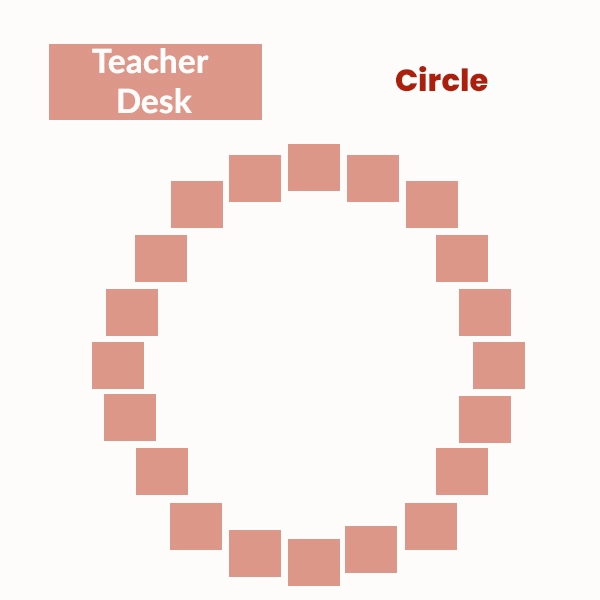
Face-to-Face Seating Arrangement in Classrooms
The face-to-face seating arrangement pairs desks so students sit directly opposite one another. This setup is a hybrid of rows and clusters, allowing for collaboration without creating significant group distractions.
- Promotes partner work and quick peer feedback
- Easy to adapt into rows or clusters for different activities
- Saves space compared to complete group pods
- Effective for classroom seating arrangements for 20–30 students in narrow rooms
Limitations:
Constant face-to-face interaction can be distracting for easily off-task students. It also may limit visibility for teacher demonstrations if students are facing away from the board.
Face-to-face seating works best when paired with clear classroom management strategies, making it a flexible option for mixed teaching styles.

Presentation-Style Classroom Seating Arrangement
The presentation seating arrangement maximizes speaker, screen, or demonstration area visibility. Desks or chairs are arranged in forward-facing rows, sometimes slightly curved to improve sightlines. This layout is popular for guest lectures, training sessions, and classroom seating arrangements for 30–40 students where content delivery is the focus.
- Ensures all students have a clear view of the presenter and materials
- Works well with technology like projectors, interactive boards, and microphones
- Simple to set up and easy to manage for large groups
- Minimizes distractions during important presentations
Limitations:
This arrangement reduces opportunities for peer interaction and, if overused, can create a passive learning environment. It’s less effective for collaborative tasks or problem-solving sessions.
For events where the goal is information delivery rather than discussion, a presentation-style seating arrangement in a classroom remains one of the most effective choices.
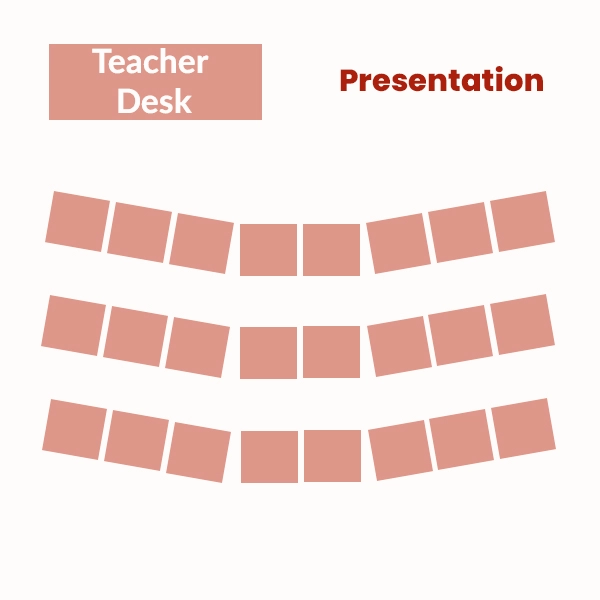
Small Conference Style Seating Arrangement
The small conference seating arrangement uses a central table surrounded by chairs, usually seating 6–12 people. This setup mirrors professional meeting spaces and is highly effective for upper-grade classrooms, seminars, or small-group discussions.
- Encourages face-to-face dialogue and active participation
- Ideal for classroom seating arrangements for small classrooms or breakout rooms
- Supports detailed project planning, peer review, and presentations
- Creates a professional, collaborative atmosphere
Limitations:
Capacity is limited, so it’s not suitable for large classes. Teachers must rotate groups if the whole class needs the same conference-style experience.
This design works well in high school classrooms, advanced courses, and project-based learning environments.
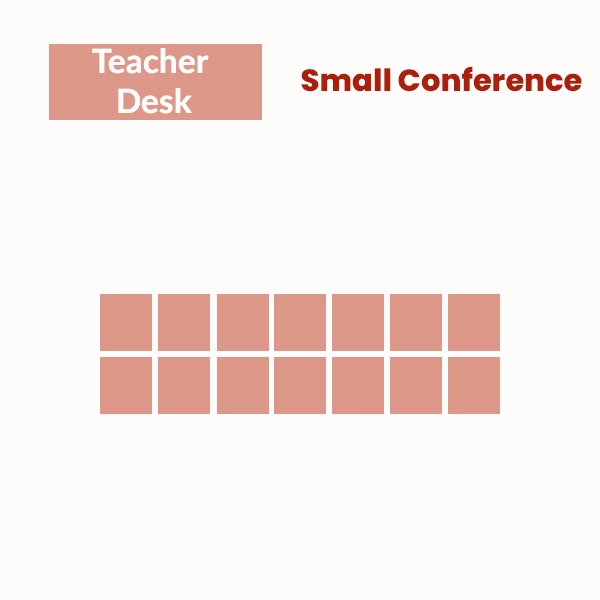
Large Conference Seating Arrangement for Classrooms
The large conference seating arrangement scales up the small conference style, accommodating 15–25 students around one or more connected tables. It is often used in debate classes, seminars, and leadership training programs.
- Allows a large number of participants to engage in structured discussion
- Maintains a central focal point for documents, materials, or technology
- Suitable for classroom seating arrangements for 20–25 students in discussion-heavy subjects
- Supports collaborative decision-making and peer evaluation
Limitations:
It requires significant floor space and may create visibility issues for students on the far ends. It works best in rooms with strong acoustics and adequate movement space.
This arrangement is ideal for academic settings that value conversation, negotiation, and equal participation.
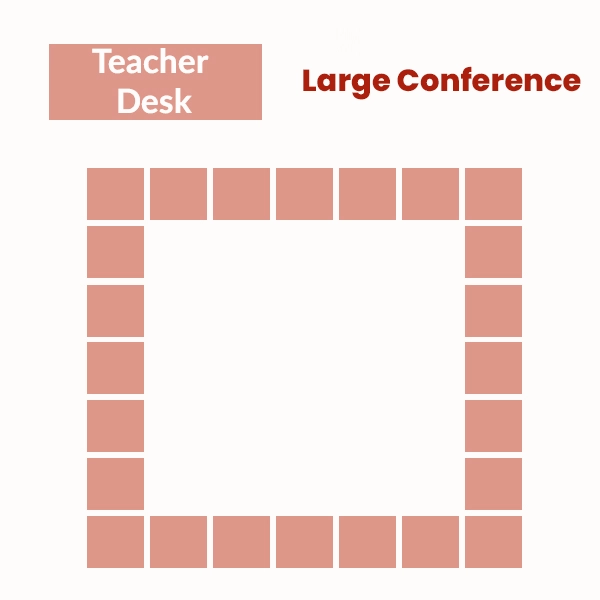
Computer Combination Seating Arrangement
The computer combination seating arrangement is designed for technology-integrated classrooms where every student needs access to a desktop or laptop. Desks are typically arranged in rows, clusters, or U-shapes with built-in computer stations. This format is standard in computer labs, STEM classrooms, and digital design courses.
- Ensures each student has equal access to technology and resources
- Can be adapted for classroom seating arrangements for 20–40 students, depending on space
- Supports technology-heavy lessons, coding, and research activities
- Easy to integrate with presentation-style seating for lectures, followed by practice
Limitations:
Requires careful cable management and power access. Fixed computer stations can reduce layout flexibility, making switching between lecture and group work harder.
For classes where technology use is central to learning, this arrangement remains one of the most effective classroom seating arrangements for productivity and focus.
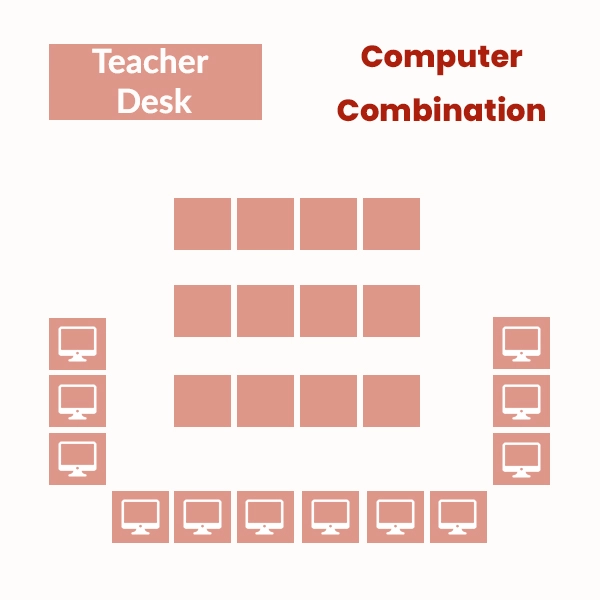
Butterfly Seating Arrangement
The butterfly seating arrangement splits the class into two angled wings facing each other and the teacher slightly. The design resembles butterfly wings, with an open center for the instructor.
- Combines the benefits of rows and group seating, allowing both direct instruction and peer interaction
- Works well for classroom seating arrangements for 28 students in a small room by using angled rows to save space
- Improves sightlines for all students without creating rigid straight rows
- Creates a natural focal point for the teacher
Limitations:
It may not be easy to manage in very narrow classrooms, and rearranging desks frequently can be time-consuming.
The butterfly layout offers a creative alternative for teachers seeking a balance between structure and collaboration.

Eye Layout Classroom Seating Arrangement
The eye layout forms an oval or eye-shaped configuration with students seated around the perimeter, and sometimes an additional row inside. This design keeps everyone connected visually while leaving room for presentations or activities in the center.
- Encourages whole-class engagement by making everyone visible
- Supports discussions, debates, and performances in the central space
- Effective for classroom seating arrangements for 20–30 students who need a mix of teacher-led and student-led activities
- Works well in inclusive classrooms to reduce isolation
Limitations:
Requires more space than traditional rows and may be challenging to fit into small classrooms.
The eye layout is handy for classes that thrive on interaction and active participation, making it one of the best classroom seating arrangements focused on community building.
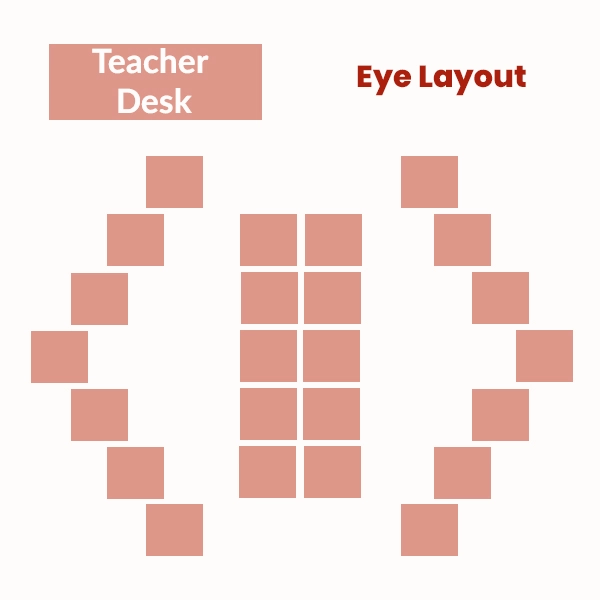
Large Group Seating Arrangements for Classrooms
The large group seating arrangement organizes students into one or two significant clusters, often around extended tables or connected desks. This format is standard in classroom seating arrangements for 30 students or more, art studios, and project-based learning spaces.
- Promotes full-class collaboration and brainstorming
- Reduces the feeling of separation between groups
- Ideal for elementary classroom seating arrangements focused on social learning
- Can integrate with flexible classroom seating arrangements to change group sizes easily
Limitations:
It may increase noise levels and make classroom management more challenging. Some students may feel lost in a large group if not actively included.
Large group layouts work best for team-building activities, cooperative learning, and situations where the focus is on collective problem-solving. Collaboration is the instructional goal and when paired with strong classroom management.

Banquet Style Seating in the Classroom
The banquet-style seating arrangement places students at round or rectangular tables, similar to event or dining setups. It is often used for classroom seating arrangements with tables in workshops, seminars, or special projects.
- Encourages informal conversation and peer-to-peer support
- Allows for easy sharing of materials in group seating arrangements in the classroom
- Creates a relaxed, community-oriented learning atmosphere
- Effective for classroom seating arrangements for small classrooms when compact tables are used
Limitations:
It can limit the teacher’s or board’s direct visibility, requiring movement during instruction. This is not ideal for traditional lecture-based lessons.
Banquet style is particularly effective in creative classroom seating arrangements and settings where collaboration and comfort are key.
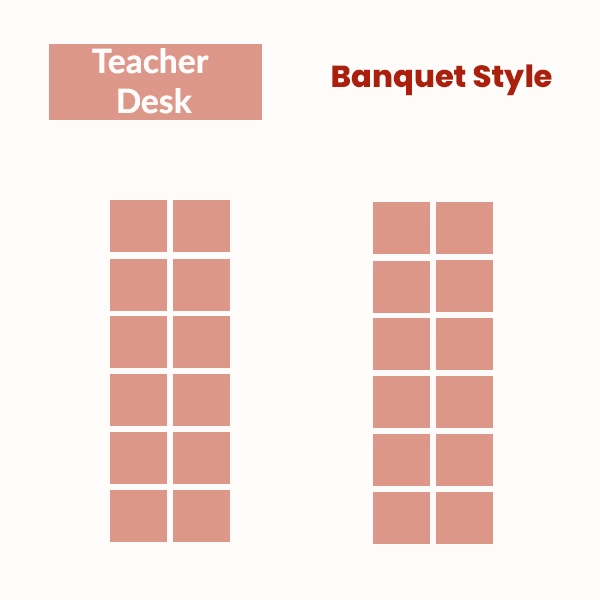
L-Shaped Classroom Seating Arrangement
The L-shaped seating arrangement in a classroom places desks or tables along two adjoining walls or sections of the room, forming an “L” shape. This design is helpful for multi-purpose classrooms that combine teaching areas with workshop or lab space.
- Maximizes floor space for activities in the open area
- Keeps all students within a manageable visual range for classroom management
- Supports hybrid activities, where one side of the L is for group work and the other for individual tasks
- Suitable for classroom seating arrangements for small classrooms with irregular layouts
Limitations:
Students at one end of the “L” may feel disconnected from the other side. Works best with smaller groups to maintain cohesion.
The L-shaped layout is a practical solution for teachers needing flexibility while making the most of unique classroom dimensions.
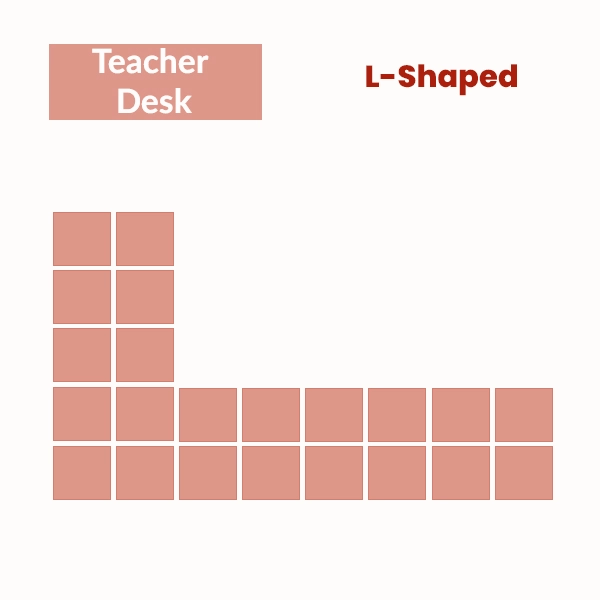
Herringbone Seating Arrangement
The herringbone seating arrangement in the classroom angles desks diagonally toward the front, creating a V-shaped pattern on both sides. This design improves sightlines for all students, even in classroom seating arrangements for 40 students or more, and is often used in lecture halls or rooms with a central focal point.
- Provides better board visibility than straight rows
- Reduces neck strain and awkward turning during lessons
- Works for both presentation-style classroom seating arrangements and group discussions
- Keeps the teacher’s movement paths clear for classroom management
Limitations:
May require more floor space than traditional rows. In small classrooms, the angled desks can reduce walking areas.
The herringbone arrangement combines order with improved visibility, making it one of the most effective classroom seating arrangements for larger or tech-equipped rooms.
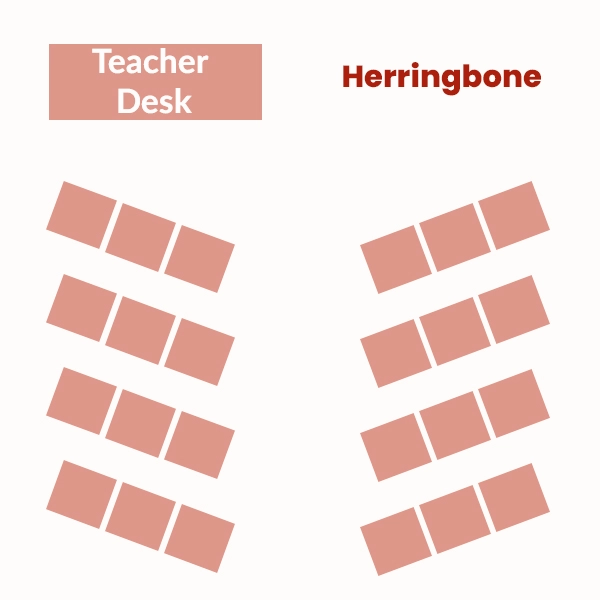
Flexible Modular Seating Arrangement
The flexible modular seating arrangement uses lightweight, movable desks and chairs that can be rearranged quickly. It supports multiple configurations—rows, clusters, circles—depending on the lesson’s needs. This is popular in 21st-century classroom seating arrangements and flexible seating classroom arrangements.
- Allows quick transitions between lecture, group work, and individual study
- Adapts to different types of classroom seating arrangements without fixed layouts
- Supports inclusive classrooms by offering varied seating options for comfort and accessibility
- Ideal for classroom seating arrangements for social distancing, as spacing can be adjusted easily
Limitations:
Requires storage space for unused furniture and can be distracting if rearranged too often.
Flexible modular seating is a go-to for modern teaching, offering adaptability without sacrificing classroom flow.
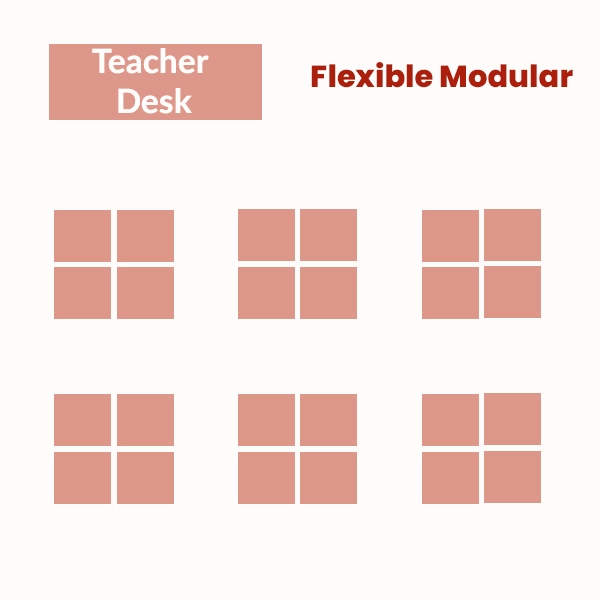
Hybrid / Mixed Classroom Seating Arrangement
The hybrid or mixed classroom seating arrangement combines two or more layouts, such as traditional rows with group pods or U-shaped classroom seating arrangements with a conference area. This design is tailored to the teacher’s unique instructional style and the students’ learning needs.
- Maximizes the benefits of different classroom seating arrangements in one space
- Supports varied activities—lectures, discussions, and projects—without major reconfiguration
- Works well for classroom seating arrangements for 30 students with diverse learning styles
- Provides flexibility in managing both collaborative and independent work
Limitations:
Planning is more complex, and the room can feel cluttered without clear zones.
The hybrid approach is one of the best classroom seating arrangements for dynamic, multi-purpose teaching, allowing educators to shift focus seamlessly.
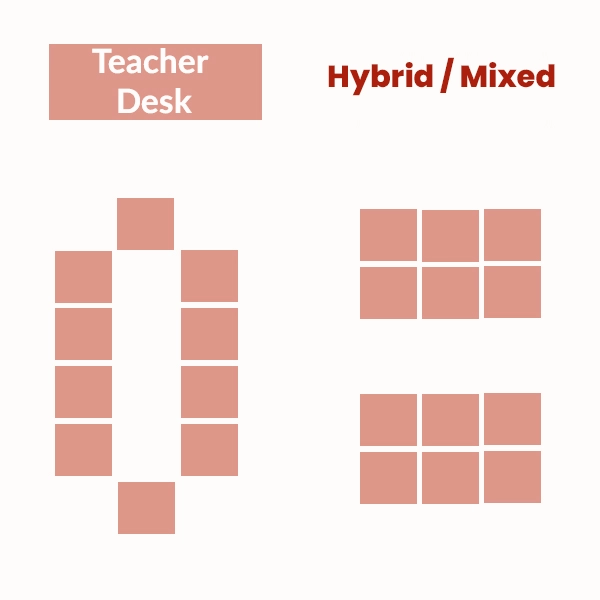
Creative and Modern Seating Ideas for Flexible Classrooms
Many teachers have moved away from fixed, traditional seating in recent years. Instead, they embrace flexible classroom seating arrangements that adapt to different activities, learning styles, and class sizes. These layouts give students more freedom and create a dynamic learning space that feels fresh and engaging.
The goal is not just comfort, but also to improve focus, boost collaboration, and make learning more student-centered. Below are some modern classroom seating arrangement ideas and how they compare to traditional layouts.
Traditional vs. Modern Flexible Seating
| Feature / Aspect | Traditional classroom seating arrangements | Modern Flexible Seating Arrangements |
|---|---|---|
| Layout | Fixed rows or U-shape | Movable desks, multi-zone areas, varied seating options |
| Flexibility | Limited; requires effort to change | High; can be reconfigured quickly |
| Student Choice | Minimal; teacher assigns seats | High; students often choose where and how to sit |
| Technology Integration | Limited positioning for screens and devices | Designed around tech use, charging stations, interactive areas |
| Collaboration | Mostly front-facing, limited group work | Multiple zones for group, pair, and individual tasks |
| Comfort | Standard chairs and desks | Bean bags, stools, standing desks, cushioned seats |
| Aesthetic Appeal | Uniform, formal | Varied, colorful, inviting |
Modern Seating Ideas for Flexible Classrooms
1. Mobile Desks and Chairs
Lightweight, wheeled desks and chairs let teachers change layouts in minutes. Products like Smith System Interchange Diamond Desks or Virco 4000 Series Mobile Desks can be arranged in clusters, rows, or circles without heavy lifting. This is perfect for switching between lectures and group work in a single lesson.
2. Collaboration Zones
Divide the classroom into zones for different purposes — group tables for projects, quiet corners for individual work, and open spaces for discussions. Modular furniture systems such as HON Build Tables or Steelcase Verb Tables make it easy to reconfigure zones based on daily activities.
3. Standing Desks and High Tables
Standing desks, like the Luxor Adjustable Stand-Up Desk, allow students to work while standing, improving energy and focus. High tables with stools are great for quick group meetings or brainstorming sessions, especially in STEM and art classes.
4. Soft Seating for Reading and Reflection
Comfortable seating such as bean bags (Fatboy Original), lounge chairs, or floor cushions can make reading areas more inviting. These are especially effective in elementary and middle school settings, where a relaxed environment helps encourage a love for reading.
5. Technology-Integrated Seating
Arrange furniture so every student can easily see interactive screens or plug in a device. Products like Smith System Flavors Noodle Chairs (with tablet arms) or collaboration hubs with built-in charging ports support
6. Outdoor Learning Spaces
Like Folding Chairs or Outdoor Folding Tables, portable seating allows teachers to take lessons outside. This alternative approach can refresh student focus and encourage a stronger connection with the environment.
Flexible layouts are part of the shift toward 21st-century classroom seating arrangements. They:
- Allow quick adaptation to different lesson formats.
- Give students ownership over their learning space.
- Integrate technology seamlessly into daily activities.
- Support both collaboration and independent work.
- Create a visually appealing, welcoming classroom.
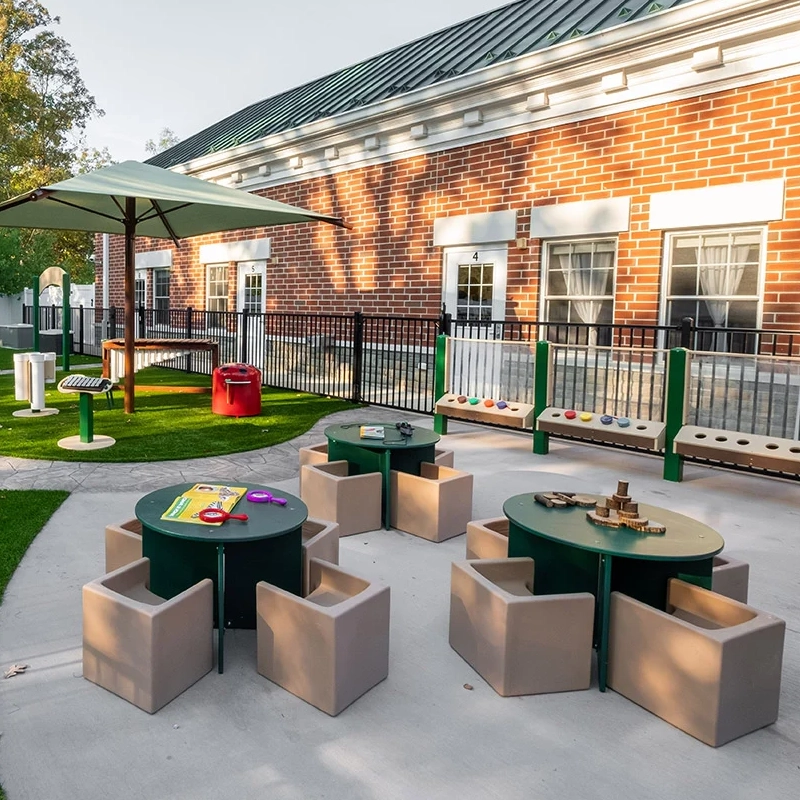
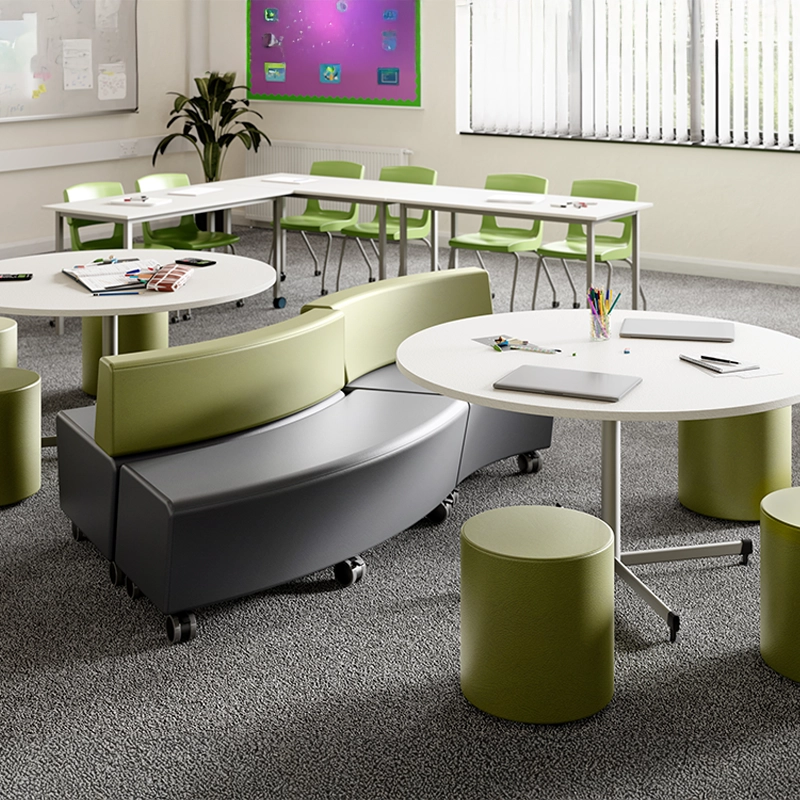
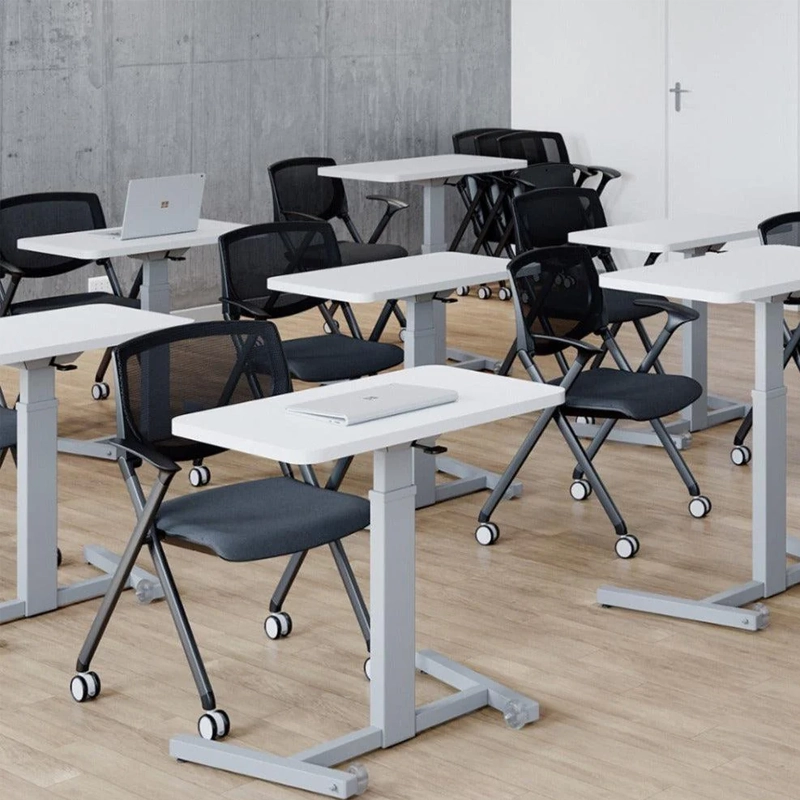
Send us a message if you have any questions or request a quote. Our experts will give you a reply within 48 hours and help you select the right product you want.
How Classroom Seating Affects Student Learning and Performance
The arrangement of a classroom is not just a matter of furniture placement — it is a strategic decision that shapes how students engage, process information, and connect. Well-designed classroom seating arrangements create an environment that supports focus, promotes participation, and fosters a positive classroom culture. Poorly considered layouts, on the other hand, can lead to disengagement, lower achievement, and even behavioral challenges.
At its core, the seating arrangement influences learning through three main channels: visibility, proximity, and interaction. Each element affects how students access information, collaborate, and feel in the learning space.
Impact on Engagement, Focus, and Academic Success
Visibility and Access to Information
Students learn more effectively when they can see and hear the lesson content without effort. Poor visibility forces them to spend mental energy accessing information rather than processing it. Well-planned classroom seating arrangements ensure that no student is positioned where their view of the board, screen, or teacher is obstructed. This visual access supports comprehension, note-taking accuracy, and sustained attention.
Proximity and Teacher Interaction
Where a student sits influences how often they interact with the teacher. Students seated closer to the instructional area frequently receive more eye contact, feedback, and opportunities to ask questions. This increased interaction can build confidence and clarify misunderstandings more quickly. Adequate classroom seating arrangements consider the balance between keeping students close enough for engagement, yet spread out enough to avoid overcrowding or tension.
Minimizing Distractions
Attention is fragile, and seating plays a significant role in protecting it. Poorly designed layouts can place easily distracted students in high-traffic areas or within view of too many stimuli. A thoughtful seating arrangement in the classroom minimizes visual and auditory disruptions by positioning students strategically, allowing them to concentrate on the task at hand. This is particularly important in larger classes where managing focus is more challenging.
Encouraging Active Participation
Engagement is not just about listening — it’s about contributing. Seating that allows students to see and respond to one another naturally promotes discussion. When learners are positioned to make eye contact and exchange ideas, they become active participants in the lesson rather than passive observers. Adequate classroom seating arrangements facilitate this dynamic by supporting group dialogue without sacrificing order.
Linking Engagement to Academic Performance
The relationship between seating and academic outcomes is well established. Students who are engaged, focused, and included in the lesson flow tend to retain information better and perform more successfully in assessments. By designing classroom seating arrangements that optimize visibility, proximity, and interaction, teachers are essentially creating the conditions for higher academic achievement.
Social-Emotional and Collaborative Learning Benefits
Creating a Sense of Belonging
A well-planned classroom seating arrangement can make students feel valued members of the learning community. When students are positioned so they can see and interact with their peers, a sense of inclusion develops. This sense of belonging is a powerful motivator, reducing feelings of isolation and encouraging students to participate more openly in classroom activities.
Encouraging Peer-to-Peer Interaction
The ability to easily communicate with classmates fosters collaboration and problem-solving. Seating layouts that promote proximity and visibility between students naturally encourage these interactions. Over time, these exchanges strengthen relationships and create a more cooperative classroom culture, essential for collaborative projects and group discussions.
Promoting Equity in Participation
Some students naturally speak up more than others, but seating can help balance participation. Strategic classroom seating arrangements ensure that quieter students are positioned where they can be seen and heard, while more vocal students are placed in ways that encourage them to share space and listen to others. This helps maintain a respectful and inclusive discussion environment.
Supporting Emotional Safety
Emotional comfort plays a significant role in learning. When seating positions reduce social anxiety—by avoiding situations where a student feels overly exposed or cornered—students can engage without fear of judgment. A thoughtful seating arrangement in the classroom can provide this balance, making the learning space feel safe and supportive.
Building Collaborative Skills for the Future
Collaboration is a skill that extends far beyond the classroom. Seating that encourages group problem-solving, active listening, and compromise helps students develop interpersonal skills they will use in future academic and professional settings. By embedding these opportunities in everyday classroom seating arrangements, teachers prepare students for real-world teamwork.
Support for Special Needs and Diverse Learners
- Ensuring Physical Accessibility
An inclusive classroom seating arrangement starts with ensuring every student can move comfortably through the space. Clear pathways, wider aisles, and adaptable desk layouts allow students with mobility challenges to navigate without obstacles. This not only supports independence but also prevents disruptions to the lesson flow.
- Reducing Sensory Overload
The environment can either help or hinder learning for students with sensory sensitivities. Seating them in calmer areas—away from noise sources, bright lights, or heavy traffic—reduces overstimulation. In well-designed seating arrangements for classrooms, these spaces are integrated naturally so that students feel part of the group while still having the support they need to focus.
- Accommodating Different Learning Styles
No two students process information in the same way. Some benefit from direct sightlines to the teacher, while others thrive when surrounded by peers for discussion. Flexible classroom seating arrangements allow teachers to position students according to their learning preferences, ensuring each learner gets the best possible environment for engagement.
- Encouraging Inclusive Interaction
Thoughtful seating design helps integrate students with different needs into group activities without singling them out. By placing students in positions that foster equal participation, the seating arrangement in the classroom promotes empathy, respect, and collaborative learning across the whole group.
- Adapting Quickly to Changing Needs
A class’s needs can shift from one day to the next. Flexible layouts that can be rearranged quickly ensure that students with special requirements always have the seating support they need—whether for a group project, individual work, or a presentation. This adaptability makes the classroom truly inclusive daily.

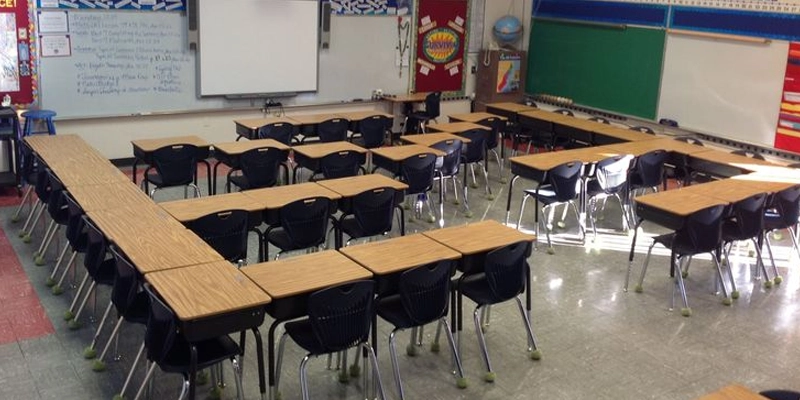
How to Choose and Implement the Right Seating Arrangement
Choosing the right classroom seating arrangement is more than placing desks in rows or clusters. It requires understanding your space, your students, and your teaching goals. The proper layout can improve focus, encourage participation, and make learning more enjoyable.
Assessing Classroom Conditions
Number of Students and Room Size
The number of students and the physical size of the room will shape your classroom seating arrangement choices. A small room with many students requires careful planning to avoid overcrowding, while a larger space allows for more flexible layouts. Always measure the room and consider movement paths for safety and comfort.
- How many students will use the classroom?
- What is the exact size and shape of the room?
- How much personal space does each student need?
- Are there fixed features (doors, windows, columns) that limit layouts?
- Is there enough space for safe movement and group activities?
Available Classroom Furniture and Technology
Your current furniture and equipment can either expand or limit your seating options. Movable desks and tables allow flexible classroom seating arrangements, while fixed furniture requires more creative planning. Technology placement — such as screens, projectors, and outlets — also plays a key role in ensuring visibility and accessibility for all students.
- What furniture do you already have?
- Are desks and chairs fixed or movable?
- Do you have tables for group or project work?
- How are electricity and technology used in this room?
- Are screens, projectors, and outlets easy for all students to access?
- Will furniture and tech placement allow all students to see and hear clearly?
Need for Accessibility and Special Education Support
A good classroom seating arrangement should make the space accessible and comfortable for all students, including those with mobility needs, sensory sensitivities, or other special requirements. This means planning for wider aisles, open pathways, and seating options that reduce distractions. Supporting special education needs is not just about compliance — it’s about creating a learning environment where every student can participate fully.
- Are aisles wide enough for wheelchairs or mobility aids?
- Can all students move freely without obstacles?
- How are you supporting neurodivergent learners?
- Are there quieter areas for students sensitive to noise or movement?
- Is the seating flexible enough to adapt to changing needs?
Matching Layout to Learning Needs
Designing classroom seating arrangements that align with students’ learning is essential for engagement and productivity. A seating plan should reflect both the learning styles of your students and the demands of your lessons. When these factors are balanced, you create an environment where students can focus, collaborate, and perform at their best.
1. Students’ Learning Styles and Group Dynamics
Every class contains a mix of learners — visual, auditory, and kinesthetic. Visual learners need clear sightlines to the board or screen, while auditory learners benefit from arrangements that allow them to hear clearly during discussions. Kinesthetic learners thrive when the seating arrangement in the classroom provides space for movement and hands-on activities.
Another factor is group dynamics. Some students work better in small groups, while others prefer independent tasks. Balancing collaboration with individual focus is key to adequate classroom seating arrangements. Too much group interaction can distract specific learners, while too much isolation can reduce peer learning opportunities. Choosing the proper seating layout — such as clusters for teamwork or rows for lectures — can help manage these dynamics.
2. Subject and Activity Requirements
Different subjects and activities require different types of classroom seating arrangements. Science lessons may need lab benches or modular desks for experiments, while language classes benefit from face-to-face setups that encourage conversation. Math lessons might work well in rows for focus, but switch to small groups for problem-solving sessions.
Activity types also influence layout. Lectures require all students to face the instructor, discussions work better in circles or U-shaped arrangements, and experiments may need open space for movement. An adaptable seating arrangement in classrooms lets you adjust quickly between these modes, ensuring each activity gets the setup it needs.
Implementing and Adjusting Your Arrangement
Choosing a classroom seating arrangement is only the first step. The real challenge is implementing it and ensuring it works for your students. Even the most effective classroom seating arrangements need fine-tuning once lessons begin. The goal is to observe, adjust, and adapt until the seating supports teaching goals and student needs.
1. Start Small and Test
Begin with a short trial period. Whether you are using a traditional classroom seating arrangement or a flexible seating classroom arrangement, try it for one or two weeks before making it permanent. This gives you time to see how students interact, whether they can see and hear clearly, and if the layout works for different activities.
2. Monitor Student Engagement and Performance
Pay attention to signs of increased focus, participation, and collaboration. Sometimes, moving one or two students can reduce distractions. Keep an eye on whether the seating arrangement in the classroom is helping or hurting student learning outcomes.
3. Gather Feedback from Students and Colleagues
Ask students about comfort, visibility, and group dynamics. Colleagues may have practical suggestions based on what works in their classrooms. This feedback can highlight small changes that make a big difference in improving classroom seating arrangements.
4. Adjust for Different Purposes
Your seating plan should not be static. For example:
- Switch to group seating arrangements in the classroom for project-based work.
- Use a U-shaped seating arrangement in a classroom for debates and presentations.
- Return to row seating for exams or focused writing sessions.
Adjusting seating arrangements for different purposes ensures flexibility and keeps the classroom responsive to learning needs.
5. Keep a Long-Term Review Cycle
Revisit your classroom seating arrangement every term or semester. Changes in class size, subject focus, or student needs may require an update. Long-term monitoring ensures your layout remains one of the most effective for your teaching style.
The best classroom seating arrangements are never “set and forget.” They grow and change with your students, just like your teaching. A seating plan that works today might need adjusting tomorrow — and that’s a sign of a responsive, student-centered classroom.
Conclusion
How you design and use your classroom seating arrangements can shape the learning experience. Each arrangement offers unique benefits and challenges, from traditional rows to creative, flexible layouts. The key is to choose a setup that matches your teaching goals, supports your students’ learning styles, and adapts to different activities.
An effective seating arrangement in the classroom is never just about where students sit — it is about creating an environment that encourages focus, collaboration, and active participation. Whether arranging seating for 20 students in a small room or 40 students in an ample lecture space, thoughtful planning and regular adjustments will help you create one of the best classroom seating arrangements for your needs.
By exploring different seating options, integrating modern flexible layouts, and refining your plan over time, you can build a learning space that works for every student. The most successful classrooms are those where the seating arrangement is not fixed, but evolves with the learners inside it.
FAQs
1. How does classroom seating affect student learning?
Seating arrangements shape how students focus, participate, and interact. Research indicates that the seating layout should match the learning task. For instance, rows work best for independent tasks and minimizing disruptions, while clustered or semi-circle setups enhance collaboration and discussion.
2. Is flexible seating beneficial for very talkative students?
Yes. Flexible seating allows teachers to place talkative students in spots that balance their energy with others’, reducing disruptions. Mixing seating zones or using choices early in the year can also help diffuse energy and structure peer interactions.
3. When should flexible, student-choice seating be re-evaluated?
Survey teacher experiences show that allowing free seating for the first few weeks works well. After observing student interactions, a more structured seating plan (like mixing academic levels in “pods of four”) often promotes better engagement and behavior.
4. What common mistakes do teachers make when creating seating charts?
- Ignoring individual learning or behavior needs (e.g., IEP/504 requirements).
- Assuming student friendships lead to productive collaboration.
- Sticking with one layout without revisiting it.
- Being intentional from the start helps prevent disruptions and promotes equitable participation.
5. How can seating enhance classroom management?
Despite the trend toward creative layouts, many educators recommend rows—especially for younger or more disrupted classes—because they improve visibility, reduce distractions, and simplify monitoring.
6. Are there any ergonomic or health considerations in flexible seating?
Absolutely. Studies on flexible classrooms show that mixing physical movement (standing, shifting, choosing seat types) can boost attention, lower stress, and improve overall wellness. Extended static layouts, especially rows, may contribute to posture issues.




